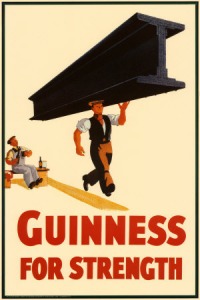The term “big beer” typically refers to beers that have a higher gravity, or alcohol content, than most other beers. I will soon be reviewing Dogfish Head’s “World Wide Stout” and I thought I’d take the time to explain what it is that makes these beers so unique.
For reference, most beer ranges from 4-6% alcohol. Usually, the higher stuff, IPA’s and Belgian ales, will range from 7-12% alcohol. The big beers will range from 12-20% alcohol. Any higher is practically impossible using traditional methods. World Wide Stout is 18% alcohol.
Below is a very brief overview of how beer is made:
– Malted barley is boiled in water. This releases, among other things, sugar into the water creating what is called “wort.”
– Because of the sweetness of the wort, hops are added to tone down the sweetness and add some bitterness and flavor. Hops are responsible for the “bite” that some beers have.
– Finally, the most important ingredient, yeast. Yeast determines whether a beer is a lager or an ale and, for purposes of this discussion, how much alcohol is in a beer.
Yeast is a living organism and, much like you and I, consume and create waste. The waste that yeast expels however, unlike you and I, is actually useful. Yeast consumes the sugar in the wort and expels CO2 and ethanol (alcohol) in it’s place. Thus, a carbonated, alcoholic drink! Once the yeast is added, it’s left to do it’s thing for about 2 weeks on average.
So how do you increase the alcohol content of a beer? The obvious answer is add more sugar and yeast. So, more malts = more sugar + more hops to balance out the sugars + more yeast to eat up all the sugar = more alcohol!
So how much more malts and hops are needed for the big beers? Dogfish Head’s 120 Minute IPA has the highest alcohol content of any other IPA at 18%. Dogfish has explained that for them to brew 120 Minute, they need “over 7 times the volume of malt and over 30 times the volume of hops than your average light lager.” Not only that, it is also “aged over 5 times longer than the average ale.”
To make these beers, it’s not just as simple as adding more ingredients either. It’s also very difficult to do so as well. Remember, ethanol is a waste product of yeast. Much like how neither you or I could live in a house of our own waste, ethanol is toxic to yeast. Meaning in high alcohol environments, yeast dies off rather than eating more sugar and creating more alcohol. This is why creating a beer thats over 20% alcohol is nearly impossible using traditional methods. There has to be a balance between the sugar, yeast, and alcohol.
More ingredients, higher difficulty level and longer time to complete the fermentation period mean that these are very expensive beers to make. For Dogfish Head to produce 120 Minute IPA it costs them half a million dollars! It is likely the same cost for their other big beers. For the single 12 oz bottle of World Wide Stout, Ho Foods (Whole Foods) charged me $10. Compare that to the usual $10-12 it’s costs for any other micro-brewed six pack.
That is why the big beers are so rare, expensive and unique. Few breweries can afford to take the risk of producing something of this caliber. Last year, Dogfish Head had to dump their productions of 2 of their big beers due to the lack of continued fermentation. This cost the company almost a million dollars in lost profits.
I’ve never personally tried any of Dogfish Heads big beers so I am very excited to try out the World Wide Stout that I purchased!

